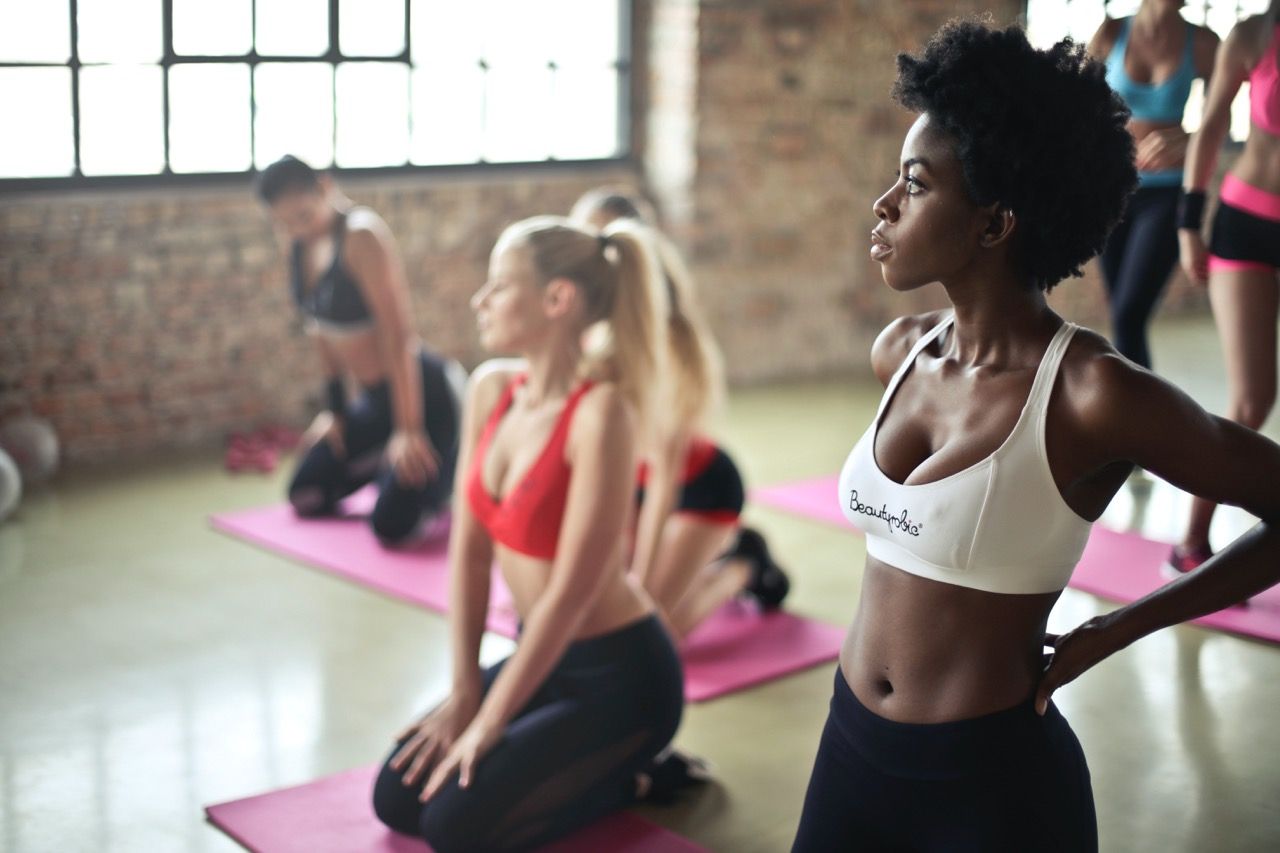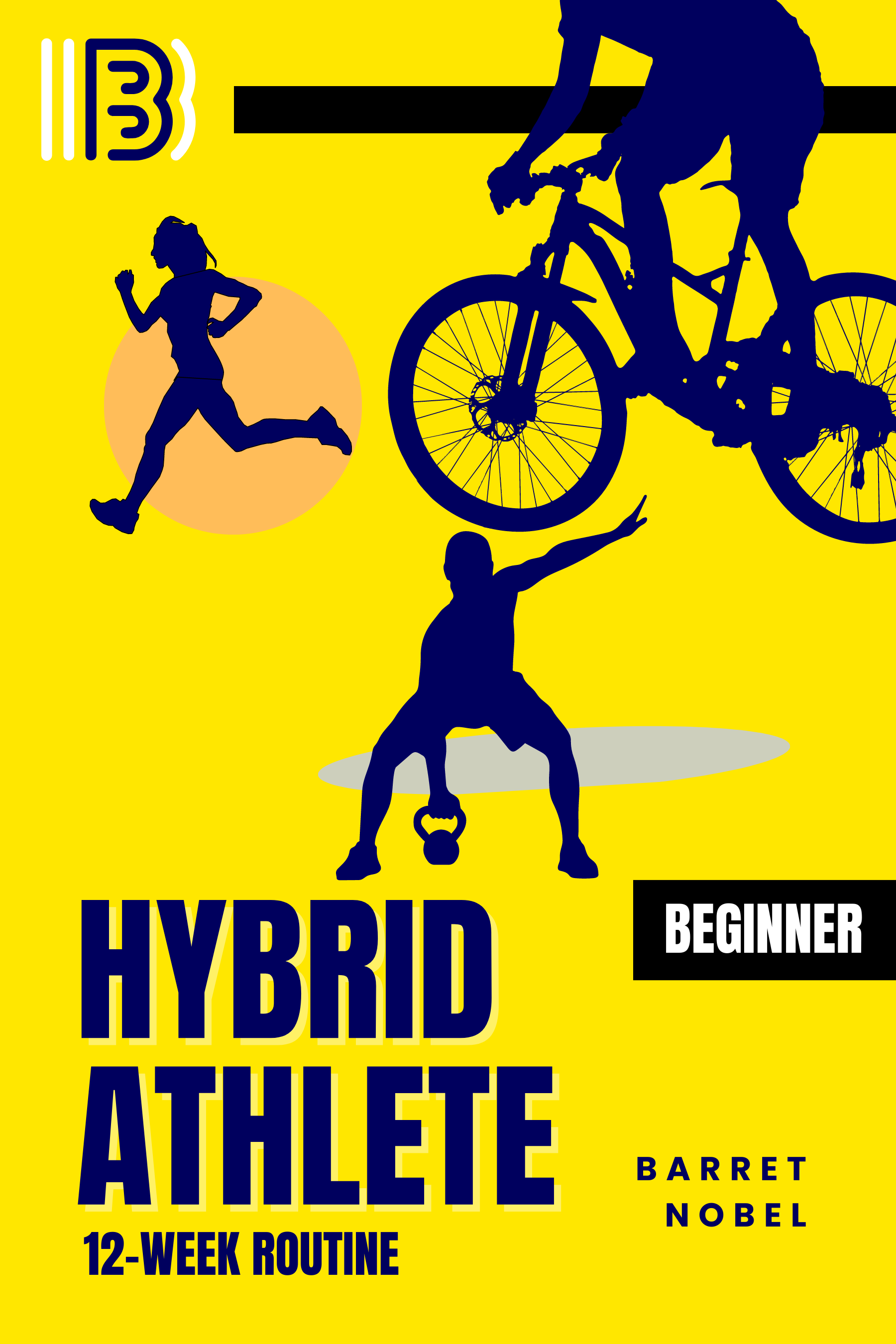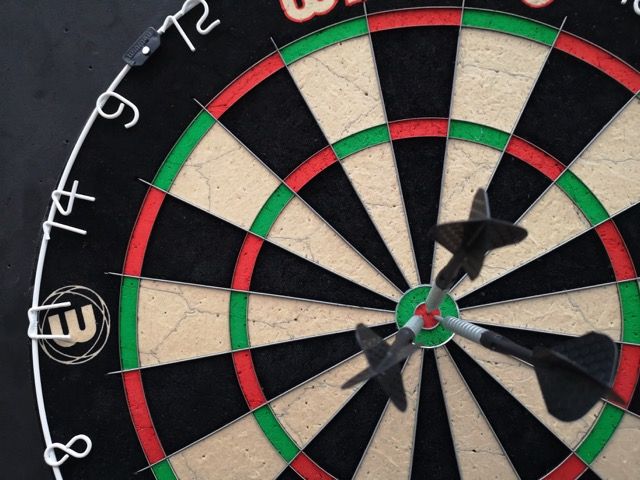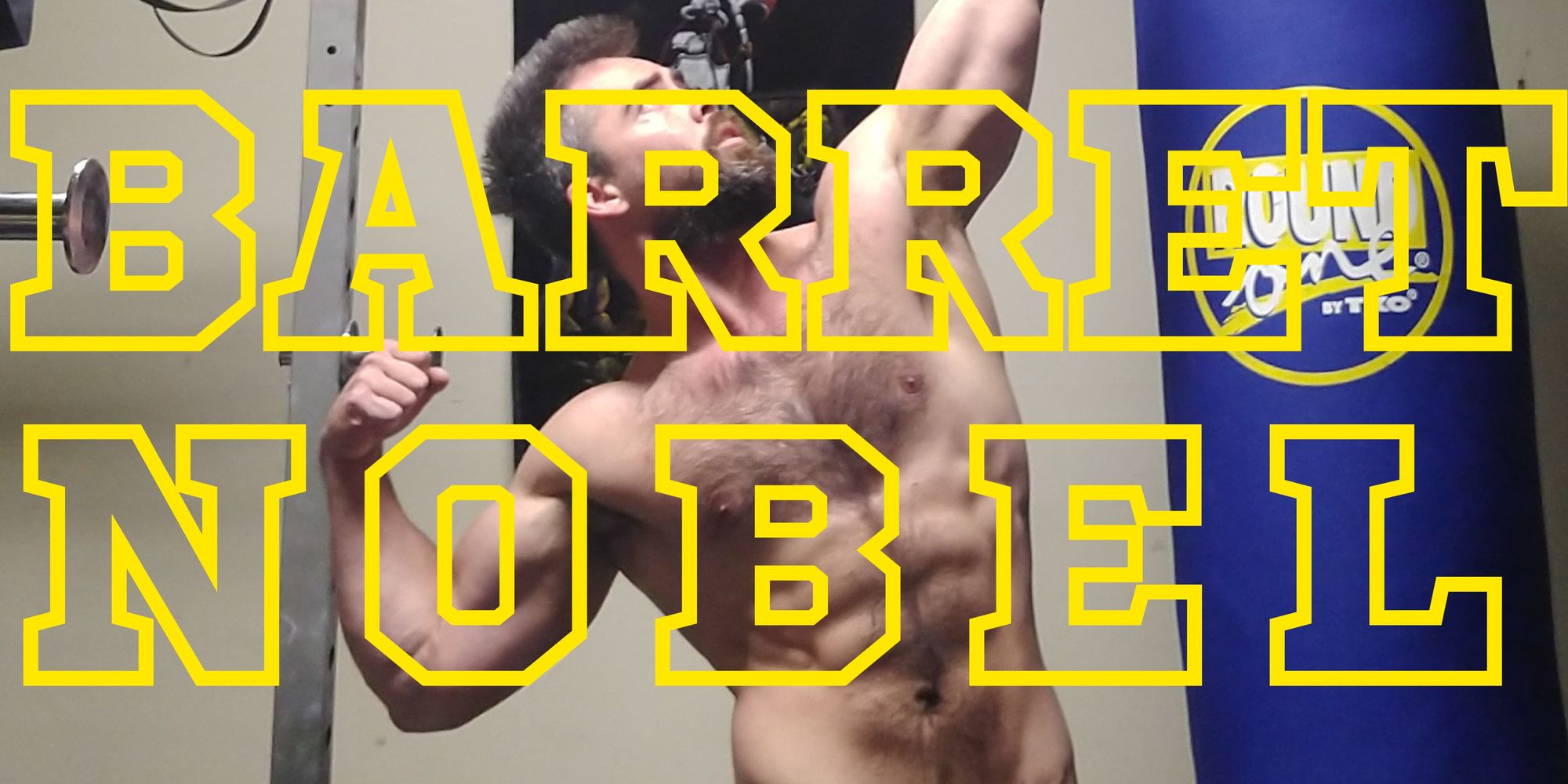Hybrid Athlete vs Traditional Athlete: Who Wins?
Discover the advantages and challenges of hybrid and traditional athletes, real-world examples, and how to choose the right athletic path for you.

In the world of sports, there's an ongoing debate about the supremacy of hybrid athletes versus traditional athletes. But who truly comes out on top? Is it the versatile, all-around athlete, or the specialized, traditional one? In this article, we'll deep dive into the differences between these two types of athletes, their benefits, and challenges, as well as real-world examples and the future of sports. Let's begin!
Explore some of the sponsors of this blog and discover cool apps, products, or websites that I'm currently using and loving by visiting the links below 👇
Do Hard Things*: Achieve fitness goals with Fit for Life, a minimalist log book for men and women. Track progress and set monthly goals with expert design.
LMNT: Stay Salty! A tasty electrolyte drink mix that is formulated to help anyone with their electrolyte needs and is perfectly suited to folks fasting or following low-carb, whole-food diets
Hypefury: Schedule & Automate Social Media Marketing Your personal assistant to grow & monetize your Twitter audience
Fancy Hands: My VA of choice! I’m pretty excited to hand off some of my work. Thought you’d be interested too. As a bonus, you'll get 50% off your first month
yourcompany.com: Interested in sponsoring this blog? 📩 → blogSponsor@hybridathletepro.com
Defining a Hybrid Athlete
A hybrid athlete is an individual who excels in multiple sports or disciplines, often combining different training methods and techniques to achieve optimal performance. These athletes are known for their ability to adapt and excel in various athletic arenas, not just focusing on a single sport. They can switch between different types of physical activities, showcasing a unique blend of skills and capabilities.
Hybrid athletes often participate in cross-training, which allows them to develop a broader range of skills and improve their overall fitness. By diversifying their training regimen, they become more adaptable and versatile, capable of tackling different challenges across various sports. This adaptability is a key feature of hybrid athletes, setting them apart from their traditional counterparts.
Defining a Traditional Athlete
A traditional athlete, on the other hand, is an individual who specializes in a single sport or discipline. These athletes dedicate their time, energy, and resources to mastering the specific skills, techniques, and strategies required to excel in their chosen field. Traditional athletes often have a deep understanding of the nuances of their sport, allowing them to achieve a high level of proficiency and success.
Unlike hybrid athletes, traditional athletes prioritize specialization over versatility. They focus on honing their skills in one specific area, often at the expense of developing a broader range of athletic abilities. This single-minded focus enables them to compete at the highest levels in their chosen sport, as their expertise is tailored to the unique demands and challenges it presents. However, this specialization may limit their adaptability to other sports or disciplines, in contrast to the well-rounded skill set of hybrid athletes.

Differences between Hybrid and Traditional Athletes
There are several key differences between hybrid and traditional athletes, which impact their approach to training, competition, and overall performance.
Training Approach
Hybrid athletes engage in cross-training, incorporating various sports or disciplines into their fitness regimen. They focus on developing a well-rounded skill set, aiming for proficiency in multiple areas. This approach enhances their adaptability and resilience, making them more versatile and capable of tackling diverse challenges.
In contrast, traditional athletes concentrate their training efforts on a single sport or discipline. They seek to master the specific skills, techniques, and strategies required for success in their chosen field. This specialization allows them to achieve a high level of expertise, but it may limit their adaptability to other sports or disciplines.
Performance
Hybrid athletes often display exceptional performance across multiple sports or disciplines. Their diverse training background equips them with a range of skills and physical capabilities, enabling them to excel in various athletic arenas.
Traditional athletes, on the other hand, achieve peak performance in their chosen sport or discipline. Their focused training approach enables them to develop a deep understanding of the nuances and intricacies of their sport, which translates to outstanding results in their specific field.
Athletic Goals
Hybrid athletes generally pursue broader athletic goals, aiming to achieve success in multiple sports or disciplines. Their objective is to become well-rounded, versatile athletes capable of facing a wide range of challenges.
Traditional athletes have more narrow goals, focusing on achieving excellence in their chosen sport or discipline. Their aim is to dominate their specific field, often at the expense of developing a diverse skill set.
Career Trajectory
The career paths of hybrid and traditional athletes may also differ. Hybrid athletes may enjoy more diverse opportunities, as their versatile skill set makes them suitable candidates for various sports or disciplines. They may also have longer careers, as their cross-training approach can help prevent overuse injuries.
Traditional athletes, however, may have more opportunities to excel in their chosen field, gaining recognition and financial rewards for their specialization. However, their careers may be more susceptible to injury or burnout due to the intense focus on a single sport or discipline.
Benefits
Benefits of Being a Hybrid Athlete
There are several advantages to being a hybrid athlete, which stem from their versatile approach to training and competition. Some key benefits include:
Versatility
Hybrid athletes possess a diverse skill set, which allows them to excel in various sports or disciplines. This versatility can be a significant advantage in competition, as they can adapt to different challenges and situations with ease. It also opens up more opportunities for them to participate in a wider range of events and competitions.
The versatility of hybrid athletes is one of their most significant assets, setting them apart from traditional athletes. This adaptability encompasses several aspects, including:
Hybrid athletes possess a wide range of skills due to their involvement in multiple sports or disciplines. This skill diversity allows them to excel in various athletic arenas and tackle unique challenges presented by different sports. Their ability to perform well across multiple disciplines is a testament to their versatility and adaptability.
Adaptability in Competition
In competitions where multiple sports or disciplines are involved, such as triathlons, obstacle course races, or CrossFit competitions, hybrid athletes have a distinct advantage. Their well-rounded skill set enables them to handle the diverse demands of these events, which may include elements of strength, endurance, agility, and more. The adaptability of hybrid athletes allows them to navigate these complex competitions with greater ease compared to their specialized counterparts.
The versatile nature of hybrid athletes often leads to increased opportunities in the world of sports. They may be more likely to secure spots on teams or be selected for various events due to their ability to contribute in multiple ways. Additionally, their adaptability can make them valuable assets in team sports, where they can fill multiple roles or positions as needed.
In sports where rules, equipment, or strategies may change over time, the adaptability of hybrid athletes can be especially advantageous. Their broad skill set and experience in multiple disciplines allow them to adapt more readily to new challenges or changes in their chosen sports. This resilience can lead to continued success even as the landscape of their sports evolves.
Finally, the versatility of hybrid athletes can contribute to their personal growth and development. By engaging in a diverse range of sports or disciplines, they can learn new skills, challenge themselves in unique ways, and gain valuable experiences that enrich their lives beyond the realm of athletics. This well-rounded approach can lead to a more fulfilling and rewarding athletic journey.
Injury Prevention
Cross-training, a staple of the hybrid athlete's training regimen, can help reduce the risk of injury. By participating in different sports or disciplines, they can avoid overuse injuries that often occur when athletes focus too heavily on a single activity. This diversified training approach allows hybrid athletes to maintain their physical health, potentially prolonging their careers.
Injury prevention is a crucial aspect of any athlete's career, and hybrid athletes can benefit significantly from their varied training approach in this regard. Some key elements contributing to injury prevention for hybrid athletes include:
Reduced Overuse Injuries
When athletes focus primarily on one sport or discipline, they may repeatedly use the same muscle groups and movement patterns, increasing the risk of overuse injuries. Hybrid athletes, on the other hand, participate in a variety of sports and activities, which allows them to distribute the physical stress more evenly across their bodies. This diverse training approach helps reduce the risk of overuse injuries and promotes overall musculoskeletal health.
Hybrid athletes engage in cross-training, which exposes them to various movement patterns and exercises, leading to more balanced muscle development. This well-rounded approach to training can help prevent muscle imbalances, which can contribute to injuries and chronic pain. By working on different muscle groups and aspects of physical conditioning, hybrid athletes can maintain a more balanced and resilient body.
The diverse training regimen of hybrid athletes often leads to the development of better movement patterns, as they learn to perform a wide range of exercises and techniques. This exposure to various movement patterns can help them identify and correct any biomechanical issues that could contribute to injuries. Improved movement patterns can also enhance their overall athletic performance, making them more efficient and effective in their chosen sports or disciplines.

Enhanced Body Awareness
Participating in multiple sports or disciplines can help hybrid athletes develop a heightened sense of body awareness. This awareness allows them to recognize when they may be pushing their bodies too hard or performing exercises with improper form, which can lead to injuries. By understanding their bodies' capabilities and limitations, hybrid athletes can make informed decisions about their training, reducing the risk of injury.
Hybrid athletes are often more open to incorporating various recovery and rehabilitation techniques into their training routine, thanks to their diverse background in sports and physical activities. This openness to different methods can help them identify and address any issues or imbalances before they become serious problems. Additionally, hybrid athletes may be more likely to engage in active recovery, such as switching to a low-impact activity on rest days, which can further contribute to injury prevention and overall well-being.
Mental Strength
Hybrid athletes often develop a strong mental fortitude due to the diverse challenges they face in their training and competitions. Constantly adapting to new sports or disciplines requires mental resilience and the ability to cope with change. This mental strength can be a valuable asset in competition, as hybrid athletes are often better equipped to handle pressure and setbacks.
Mental strength is a vital component of an athlete's success, and hybrid athletes often develop this attribute through their diverse training and competition experiences. Some factors that contribute to the mental strength of hybrid athletes include:
Adaptability
Hybrid athletes frequently face new challenges and situations as they participate in various sports or disciplines. This exposure to diverse experiences helps them develop the ability to adapt to change and think on their feet, which is a valuable mental skill in the world of sports. The adaptability of hybrid athletes enables them to handle unexpected obstacles and setbacks more effectively, allowing them to maintain focus and composure in high-pressure situations.
Resilience
The broad range of experiences and challenges encountered by hybrid athletes can help them develop resilience, the ability to recover quickly from setbacks and continue pursuing their goals. This mental fortitude is particularly crucial in the world of sports, where injuries, losses, and other obstacles can test an athlete's resolve. Hybrid athletes' resilience allows them to bounce back from adversity and continue striving for success.
Participating in multiple sports or disciplines allows hybrid athletes to develop a more robust sense of self-confidence. As they achieve success across various athletic arenas, they gain the assurance that they can tackle a wide range of challenges and excel in diverse situations. This self-confidence can be a significant mental advantage in competitions, helping hybrid athletes maintain a positive mindset and perform at their best.
Training for multiple sports or disciplines requires a high level of discipline and focus. Hybrid athletes must manage their time and energy effectively to ensure they can excel in all their chosen activities. This ability to balance multiple demands helps them develop mental discipline and focus, which can translate into improved performance during competition.
Problem-Solving Skills
As hybrid athletes engage in various sports or disciplines, they often need to develop creative problem-solving skills to overcome unique challenges. These skills can be invaluable in competitions, as they enable hybrid athletes to analyze situations, devise strategies, and make quick decisions to gain an advantage over their opponents. The problem-solving skills of hybrid athletes contribute to their mental strength and overall success in the world of sports.
By participating in a diverse range of sports and disciplines, hybrid athletes can develop mental strength, which allows them to excel in high-pressure situations and overcome obstacles. This mental fortitude is a crucial component of their success and sets them apart from their more specialized counterparts.
Holistic Fitness
By engaging in various sports or disciplines, hybrid athletes can develop a more comprehensive and balanced level of fitness. Their cross-training approach allows them to work on different muscle groups and aspects of physical conditioning, leading to overall improvements in strength, endurance, agility, and flexibility.
Enjoyment and Motivation
Finally, the diverse training regimen of hybrid athletes can keep them engaged and motivated, as they are continually learning new skills and facing different challenges. This variety can help prevent boredom and burnout, maintaining their passion for sports and physical activity.

Benefits of Being a Traditional Athlete
Despite the potential advantages of being a hybrid athlete, there are still numerous benefits associated with being a traditional athlete. Some of the key benefits include:
Expertise in a Specific Sport or Discipline
By focusing their training efforts on a single sport or discipline, traditional athletes can develop a deep understanding of the specific skills, techniques, and strategies required for success. This specialization enables them to become experts in their chosen field, providing a competitive edge against more generalized athletes.
Developing expertise in a specific sport or discipline is one of the primary benefits of being a traditional athlete. This specialized approach enables athletes to excel in their chosen field and offers several advantages:
In-Depth Knowledge and Understanding
By focusing on a single sport or discipline, traditional athletes can develop an in-depth knowledge and understanding of the specific skills, techniques, rules, and strategies involved. This comprehensive grasp of their chosen sport allows them to make better decisions during competition and optimize their performance.
Refined Skill Set
Traditional athletes can dedicate more time and energy to refining the specific skills required for their sport or discipline. As a result, their skill set becomes highly specialized and tailored to the unique demands and challenges of their chosen field. This refined skill set can give them a competitive edge over opponents who may not have the same level of expertise.
With a clear focus on a single sport or discipline, traditional athletes can develop a targeted training regimen that addresses the specific needs of their chosen field. This efficiency allows them to make more rapid progress in their sport, leading to improved performance and results over time.
Mastery and Fulfillment
The pursuit of expertise in a specific sport or discipline can be a deeply fulfilling journey for many athletes. The process of mastering their chosen field and witnessing the tangible improvements in their performance can provide a strong sense of accomplishment and satisfaction. This intrinsic motivation can help drive traditional athletes to continue striving for success and push the boundaries of their capabilities.
This specialized approach allows them to build a deep understanding of their chosen field, refine their skill set, progress more efficiently in their training, attract recognition and opportunities, and experience a sense of mastery and fulfillment.
Opportunities for Recognition and Financial Rewards
Traditional athletes who achieve a high level of success in their chosen sport may enjoy opportunities for recognition and financial rewards. Sponsors, endorsements, and lucrative contracts are often reserved for athletes who excel in their specific field. By specializing in one discipline, traditional athletes may be more likely to gain access to these opportunities.
Clear Training Goals and Objectives
Focusing on a single sport or discipline allows traditional athletes to establish clear training goals and objectives. This clarity can help them develop a more structured and targeted training regimen, leading to more efficient progress and improvements in their chosen field.
One of the key benefits of being a traditional athlete is the ability to establish clear training goals and objectives. Focusing on a single sport or discipline enables athletes to create a structured and targeted approach to their training, which can lead to several advantages:
By having well-defined goals and objectives, traditional athletes can maintain a sense of direction and focus in their training. This clarity helps them concentrate on the specific aspects of their sport that require improvement, ensuring that their training remains purposeful and effective.
Measurable Progress
Clear training goals and objectives enable traditional athletes to measure their progress more accurately. By establishing benchmarks and targets, they can track their improvements over time and adjust their training accordingly. This measurable progress can be highly motivating, as athletes can see tangible evidence of their hard work paying off.
With a clear understanding of their goals and objectives, traditional athletes can create optimized training programs tailored to their specific needs. This customization allows them to address their weaknesses, capitalize on their strengths, and make the most of their available training time. As a result, their training becomes more efficient and effective, leading to improved performance in their chosen sport or discipline.
Having clear training goals and objectives can boost an athlete's motivation and commitment. By setting specific targets, athletes can develop a greater sense of purpose and drive, as they work towards achieving their desired outcomes. This enhanced motivation can help them overcome obstacles, persevere through challenging periods, and maintain a high level of dedication to their sport.
Informed Decision-Making
When athletes have a clear understanding of their training goals and objectives, they can make more informed decisions about their training methods, competition schedules, and other aspects of their athletic career. This insight can help them allocate their time and resources more effectively, ensuring that they prioritize the activities and opportunities that align with their long-term aspirations.
This approach to training enables them to maintain direction and purpose, measure their progress, optimize their training programs, enhance their motivation and commitment, and make informed decisions about their athletic careers. By concentrating on their specific sport or discipline, traditional athletes can develop a structured and targeted approach to their training, leading to improved performance and success in their chosen field.
Development of Sport-Specific Skills and Techniques
By dedicating their time and energy to mastering the nuances of a single sport, traditional athletes can hone their sport-specific skills and techniques to a high level. This mastery often translates to outstanding results in their chosen discipline, as their expertise is tailored to the unique demands and challenges of their sport.
Strong Sense of Identity and Belonging
Traditional athletes often develop a strong sense of identity and belonging within their chosen sport or discipline. This connection can foster a deep passion for their sport, which may contribute to their motivation and drive to excel. In addition, the sense of community and camaraderie within a specific sport can provide valuable social connections and support for traditional athletes.
While hybrid athletes may enjoy the benefits of versatility and adaptability, traditional athletes can still reap numerous rewards through their specialized approach to training and competition. By focusing on a single sport or discipline, traditional athletes can develop expertise, recognition, and a strong sense of identity, which can contribute to their overall success in the world of sports.
Challenges
Challenges of Being a Hybrid Athlete
Despite the numerous benefits of being a hybrid athlete, there are also several challenges that these individuals may face. Some of the key challenges and difficulties associated with being a hybrid athlete include:
Dilution of Focus
One of the main challenges of being a hybrid athlete is maintaining focus across multiple sports or disciplines. As they divide their time and energy among various activities, it may be difficult for hybrid athletes to devote sufficient attention to each area. This dilution of focus can hinder their progress and limit their potential for excellence in any specific sport or discipline.
Dilution of focus is a significant challenge faced by hybrid athletes, as they strive to excel in multiple sports or disciplines. Balancing the demands of various activities can lead to several issues related to focus and attention, impacting their overall performance and progress.
When hybrid athletes participate in multiple sports or disciplines, they may struggle to prioritize their time and energy effectively. As a result, their attention is divided among numerous activities, potentially leading to a lack of focus and progress in any specific sport. This divided attention can make it challenging for hybrid athletes to reach their full potential in each of their chosen pursuits.
Consistency is crucial for athletic success, but hybrid athletes may find it difficult to maintain a consistent training schedule across multiple sports or disciplines. This inconsistency can hinder their ability to develop and refine the specific skills and techniques required for each activity, potentially limiting their performance and results.
Due to the dilution of focus, hybrid athletes may not be able to dedicate the necessary time and effort to develop expertise in any single sport or discipline fully. This limitation can result in a more generalized skill set that may not be as effective when competing against specialized athletes who have honed their skills through focused training.
Conflicting Goals and Objectives
Hybrid athletes may face conflicting goals and objectives as they attempt to balance the demands of multiple sports or disciplines. This conflict can make it challenging for them to establish clear and achievable targets for their training and performance, potentially leading to a lack of direction and purpose in their athletic pursuits.

Increased Mental Fatigue
Managing the mental demands of multiple sports or disciplines can be mentally exhausting for hybrid athletes. The need to constantly switch between different training methods, strategies, and techniques can lead to increased mental fatigue, which may negatively impact their performance and decision-making abilities.
Increased mental fatigue is a significant challenge faced by hybrid athletes who participate in multiple sports or disciplines. Juggling the cognitive demands of diverse activities can take a toll on their mental well-being, potentially affecting their performance and overall athletic success.
Participating in multiple sports or disciplines requires hybrid athletes to process and retain a large amount of information, such as rules, strategies, techniques, and game plans. This increased cognitive load can lead to mental fatigue, as their brains work harder to manage and integrate the diverse knowledge required for each activity.
Decision-Making and Focus
Mental fatigue can negatively impact an athlete's decision-making abilities and focus during training and competition. As hybrid athletes constantly switch between different sports or disciplines, their ability to make quick, accurate decisions and maintain concentration may be compromised, potentially affecting their performance.
Balancing the demands of multiple sports or disciplines can increase stress and anxiety for hybrid athletes. The pressure to perform well in each activity, combined with the challenge of managing conflicting goals and objectives, can contribute to mental fatigue and strain.
Mental fatigue can also affect an athlete's recovery and sleep quality. As hybrid athletes struggle to balance the cognitive demands of various sports, their ability to relax and unwind may be compromised, potentially leading to sleep disturbances and inadequate rest. Poor sleep and recovery can further exacerbate mental fatigue and negatively impact athletic performance.
Prolonged periods of mental fatigue can increase the risk of burnout for hybrid athletes. The constant juggling of multiple sports or disciplines may lead to a decline in motivation and enjoyment of their chosen activities, potentially causing them to disengage or lose interest in their athletic pursuits.
Mental fatigue is a substantial challenge for hybrid athletes participating in multiple sports or disciplines. To mitigate these effects, hybrid athletes should prioritize effective time management, mental recovery strategies, and stress-reduction techniques to maintain optimal mental well-being and athletic performance.
Navigating Conflicting Training Approaches
Different sports and disciplines may require unique training approaches and techniques. Hybrid athletes may find it challenging to navigate and reconcile these conflicting methods, potentially leading to confusion and suboptimal training outcomes. Developing a comprehensive and cohesive training plan that accommodates the demands of multiple sports can be a complex and time-consuming process.
Hybrid athletes may find it more difficult to access specialized coaching and resources for each of their chosen sports or disciplines. As their focus is divided among multiple activities, they may be unable to dedicate the time and financial resources necessary to work with top coaches or access elite training facilities in each area. This limitation can put them at a competitive disadvantage compared to traditional athletes who focus solely on one sport.
Scheduling Conflicts and Commitment Issues
Participating in multiple sports or disciplines can lead to scheduling conflicts and commitment issues, as hybrid athletes must balance the demands of various training and competition schedules. This juggling act can create stress and strain on their personal and professional lives, as they attempt to accommodate the competing priorities of their chosen sports.
Hybrid athletes face several challenges as they strive to excel in multiple sports or disciplines. Despite these difficulties, many hybrid athletes still find the rewards of participating in diverse sports and disciplines to be well worth the challenges they face.
Challenges of Being a Traditional Athlete
While there are numerous benefits associated with being a traditional athlete, these individuals may also face certain challenges and difficulties in their pursuit of excellence in a single sport or discipline. Some of the key challenges include:
Risk of Overuse Injuries
Traditional athletes who focus on a single sport or discipline may be at a higher risk of developing overuse injuries. As they repeatedly engage in the same movements and activities, they may place excessive stress on specific muscles, joints, and connective tissues, leading to injury. Hybrid athletes, who participate in multiple sports, often benefit from cross-training, which can help reduce the risk of overuse injuries. The repetitive nature of their training and competition schedules can place excessive strain on specific muscles, joints, and connective tissues, potentially leading to injury.
Repetitive Stress and Imbalances
By concentrating on a single sport or discipline, traditional athletes engage in the same movements and activities repeatedly. This repetitive stress can lead to imbalances in muscle strength and flexibility, as certain muscles become overworked while others remain underutilized. These imbalances can increase the risk of injuries, such as tendonitis, stress fractures, and muscle strains.
Traditional athletes who specialize in a single sport may not engage in sufficient cross-training activities to support overall musculoskeletal health. Cross-training can help build strength, flexibility, and stability in muscle groups not targeted by a specific sport, potentially reducing the risk of overuse injuries.
The intense focus on a single sport or discipline can lead traditional athletes to overlook the importance of rest and recovery. Inadequate rest can exacerbate the risk of overuse injuries, as muscles, joints, and connective tissues are not given sufficient time to repair and regenerate between training sessions and competitions.
The risk of overuse injuries can also be heightened by poor technique and form during training and competition. Traditional athletes may develop bad habits or compensatory patterns in response to muscle imbalances or fatigue, placing additional strain on vulnerable areas and increasing the likelihood of injury.
Prevention Strategies
To minimize the risk of overuse injuries, traditional athletes should consider implementing the following strategies:
- Incorporate cross-training: Engage in cross-training activities that build strength, flexibility, and stability in muscles not targeted by the primary sport or discipline. This approach can help correct imbalances and reduce injury risk.
- Prioritize rest and recovery: Ensure adequate rest between training sessions and competitions to allow muscles, joints, and connective tissues to repair and regenerate.
- Focus on technique and form: Work with coaches or trainers to ensure proper technique and form during training and competition. Addressing and correcting any bad habits or compensatory patterns can help reduce injury risk.
- Monitor training load: Track and manage training volume and intensity to prevent overtraining and excessive strain on the body.
- Warm-up and cool down: Incorporate thorough warm-up and cool-down routines before and after training sessions and competitions to prepare the body for activity and promote recovery.
Limited Versatility and Adaptability
By specializing in a single sport or discipline, traditional athletes may limit their versatility and adaptability. This lack of diversity can make it more challenging for them to transition to other sports or activities if they decide to change their focus or if opportunities in their chosen sport become limited. By focusing primarily on one activity, these athletes may not develop the diverse skill set and physical abilities that can be beneficial in various situations or other sports.
Traditional athletes often develop a highly specialized skill set tailored to the specific demands of their chosen sport or discipline. While this specialization can lead to a high level of expertise, it may also result in a narrow range of abilities that do not transfer well to other activities or sports.
By concentrating on a single sport or discipline, traditional athletes may not develop a wide range of physical capabilities, such as strength, endurance, flexibility, and agility. This lack of diversity in physical abilities can limit their adaptability and overall athletic potential.
Traditional athletes may find it challenging to transition to new sports or activities due to their specialized skill set and limited physical capabilities. These athletes may struggle to adapt to the demands of different sports, potentially hindering their ability to excel in new athletic pursuits or enjoy recreational activities outside of their primary focus.
Limited versatility and adaptability may also affect an athlete's resilience to changing conditions within their primary sport or discipline. For example, a runner who specializes in long-distance events may struggle to adapt to shorter, faster-paced races. Developing a broader range of skills and physical abilities can help athletes better adapt to different conditions and challenges within their chosen sport.
Strategies to Enhance Versatility and Adaptability
Traditional athletes can take several steps to enhance their versatility and adaptability, including:
- Incorporate cross-training: Engage in cross-training activities that target different muscle groups, energy systems, and movement patterns to develop a more diverse range of physical capabilities. Cross-training can also help improve overall athleticism and reduce the risk of overuse injuries.
- Participate in complementary sports: Choose complementary sports or activities that share similar skills or movement patterns with the primary sport. Participating in these sports can help enhance the athlete's adaptability and versatility without compromising their primary focus.
- Focus on developing well-rounded fitness: Incorporate strength training, flexibility exercises, and cardiovascular conditioning into the training routine to promote overall fitness and athletic ability. A well-rounded fitness program can help traditional athletes become more adaptable to new sports or activities.
- Learn new skills: Actively seek opportunities to learn new skills or techniques outside of the primary sport or discipline. This approach can help broaden the athlete's skill set and enhance their ability to adapt to new challenges or environments.
- Embrace change and be open-minded: Cultivate an open-minded attitude towards new experiences and be willing to embrace change. Being open to new ideas and approaches can help traditional athletes become more versatile and adaptable in their athletic pursuits.
By incorporating cross-training, participating in complementary sports, focusing on well-rounded fitness, learning new skills, and embracing change, these athletes can enhance their versatility, adaptability, and overall athletic potential. This increased adaptability can help them navigate various challenges within their primary sport, transition to new sports or activities, and become more resilient athletes.

Potential for Burnout
Focusing solely on one sport or discipline can increase the risk of burnout for traditional athletes. The repetitive nature of their training and competition schedules may lead to mental and emotional fatigue, potentially reducing their motivation and enjoyment of their chosen sport.
Traditional athletes who dedicate their time and resources to a single sport or discipline may face increased pressure to succeed in their chosen field. This pressure can come from coaches, peers, family members, or even the athletes themselves, creating additional stress and anxiety that may negatively impact their performance.
By concentrating on a single sport or discipline, traditional athletes may miss out on the broader social connections and experiences that come with participating in multiple activities. This potential social isolation can limit their personal growth and development, as well as their ability to form connections with others who share similar interests.
Traditional athletes may encounter several challenges as they pursue excellence in a single sport or discipline. Despite this, many traditional athletes continue to find fulfillment and success in their specialized approach to training and competition.
Real Life Athletes
Hybrid
Hybrid athletes have gained prominence in recent years, showcasing their diverse skill sets and versatility across multiple sports and disciplines. Here are a few real-world examples of successful hybrid athletes who have excelled in various athletic pursuits:
1. Bo Jackson
Bo Jackson is a legendary American athlete known for his outstanding achievements in both professional football and baseball. He is the only athlete in history to be named an All-Star in both sports, demonstrating his exceptional versatility and adaptability.
2. Clara Hughes
Clara Hughes is a Canadian athlete who has excelled in both cycling and speed skating. She is one of the few athletes to have won multiple Olympic medals in both Summer and Winter Olympic Games, highlighting her diverse athletic abilities and prowess across different disciplines.
3. Lauryn Williams
Lauryn Williams is an American sprinter and bobsledder who has achieved success in both track and field and winter sports. She is one of a small group of athletes to have won medals at both the Summer and Winter Olympics, showcasing her adaptability and impressive skill set across distinct sports.
4. Conor McGregor
Conor McGregor is an Irish mixed martial artist (MMA) and professional boxer known for his exceptional striking abilities and charismatic personality. He has found success in both MMA and boxing, becoming the first fighter in UFC history to hold titles in two weight divisions simultaneously and competing in high-profile boxing matches against elite opponents.
5. Ashton Eaton
Ashton Eaton is a retired American decathlete who has demonstrated exceptional skill and versatility across various track and field events. Eaton won Olympic gold medals in the decathlon in both the 2012 and 2016 Olympic Games, setting world records in the process. Decathlon athletes like Eaton are prime examples of hybrid athletes, as they excel in multiple track and field disciplines, including sprinting, jumping, and throwing events.
These real-world examples of hybrid athletes showcase the incredible potential of individuals who train and compete in multiple sports or disciplines. Their versatility, adaptability, and diverse skill sets have allowed them to achieve success across various athletic pursuits, inspiring future generations of athletes to explore the possibilities of becoming hybrid athletes themselves.
Traditional
Traditional athletes have long dominated their respective sports, demonstrating exceptional skill and expertise in a single discipline. Here are a few real-world examples of successful traditional athletes who have excelled in their chosen sport:
1. Usain Bolt
Usain Bolt, a Jamaican sprinter, is widely considered the fastest man in the world. He has achieved numerous world records and Olympic gold medals in the 100m, 200m, and 4x100m relay events. Bolt's specialization in sprinting has made him a dominant force in the world of track and field.
2. Michael Phelps
Michael Phelps is an American swimmer and the most decorated Olympian of all time, with a total of 28 medals, 23 of which are gold. Phelps has focused primarily on swimming throughout his career, mastering various strokes and distances to become one of the greatest swimmers in history.
3. Serena Williams
Serena Williams is an American professional tennis player who has won numerous Grand Slam titles and Olympic gold medals. Her dedication to tennis has enabled her to excel in the sport, becoming one of the greatest female tennis players of all time.
4. Lionel Messi
Lionel Messi is an Argentine professional soccer player, widely regarded as one of the best soccer players in history. His specialization in soccer has allowed him to develop extraordinary skills, including dribbling, passing, and scoring, making him a dominant force in the sport.
5. Simone Biles
Simone Biles is an American gymnast who has become one of the most decorated gymnasts in history, with numerous world championships and Olympic gold medals to her name. Biles has dedicated her athletic career to gymnastics, showcasing her incredible talent and skill in artistic gymnastics events such as the vault, uneven bars, balance beam, and floor exercise.
These real-world examples of traditional athletes demonstrate the immense success that can be achieved through specialization and dedication to a single sport or discipline. By focusing their efforts on mastering the skills and techniques required in their chosen sport, these athletes have risen to the pinnacle of their respective fields, leaving lasting legacies and inspiring future generations of athletes to pursue their own athletic dreams.
The Future
As sports continue to evolve, the debate between the merits of hybrid and traditional athletes will persist. However, several factors may influence the future landscape of sports, including advances in technology, changes in training methods, and the emergence of new sports and disciplines. Here, we'll discuss some of these factors and their potential impact on the future of sports.
Technological innovations have already revolutionized the world of sports, from wearable devices that track athlete performance to advanced analytics for better coaching and training. In the future, technology will likely play an even more significant role in sports, with the potential to enhance training, injury prevention, and performance analysis. This could lead to a more level playing field between hybrid and traditional athletes, as technology enables athletes to optimize their training and capitalize on their natural strengths.
New and innovative training methodologies are continuously emerging, blending different disciplines and approaches to improve overall athletic performance. As these methods become more widespread, athletes may adopt a more holistic approach to training, combining the best practices from multiple sports and disciplines. This could lead to a rise in hybrid athletes who excel in various sports, challenging the notion of traditional specialization.
The Emergence of New Sports and Disciplines
The sports landscape is constantly evolving, with new sports and disciplines gaining popularity and recognition. These emerging sports may require athletes to develop diverse skill sets, fostering a new generation of hybrid athletes. Moreover, the growing popularity of multi-sport events, such as obstacle course racing and CrossFit competitions, may further encourage athletes to diversify their training and participate in multiple disciplines.
As awareness of the importance of long-term health and injury prevention grows, athletes may be more inclined to adopt a balanced approach to training, incorporating multiple sports and disciplines to minimize the risk of overuse injuries and promote overall well-being. This shift in focus could lead to a rise in hybrid athletes who prioritize health and longevity alongside athletic performance.
Expanding Opportunities for Athletes
The future of sports may also see increased opportunities for athletes to compete in multiple sports or disciplines, as organizations and competitions adapt to accommodate the growing trend of hybrid athleticism. As these opportunities expand, more athletes may be inspired to pursue diverse athletic pursuits, challenging the traditional notion of specialization.
The future of sports will likely continue to see a blend of hybrid and traditional athletes, with advancements in technology, training methodologies, and new sports influencing the landscape. The evolving nature of sports may encourage athletes to explore their full athletic potential and embrace the benefits of both specialization and versatility. As a result, the debate between hybrid and traditional athletes will persist, with the ultimate winner being determined by the individual athlete's goals, preferences, and abilities.
The Importance of Individual Goals and Preferences
When considering the debate between hybrid and traditional athletes, it's essential to recognize the importance of individual goals and preferences. Every athlete has unique aspirations, strengths, and weaknesses, which play a significant role in determining their approach to sports and training. By understanding and embracing these individual factors, athletes can develop a personalized path to success that aligns with their specific objectives and interests.
Aligning Training with Personal Goals
Athletes must first identify their personal goals in order to develop an appropriate training plan. For some, the primary objective may be to excel in a specific sport or discipline, which may necessitate a traditional approach to training. Others may prioritize overall fitness, skill development, or the enjoyment of participating in multiple sports, in which case a hybrid approach may be more suitable.
Understanding one's strengths and weaknesses is crucial for athletes when deciding between a hybrid or traditional approach. Some athletes may naturally excel in multiple sports, making a hybrid approach more appealing, while others may find greater success focusing on a single discipline that best matches their natural abilities.
Athletes should also consider the balance between enjoyment and competition when making their choice. Some individuals may derive greater satisfaction from participating in a variety of sports and activities, while others may prefer the challenge and focus that comes with specialization. Ultimately, athletes should choose an approach that aligns with their personal preferences and brings them the most enjoyment.
Considering Long-Term Objectives
Long-term objectives play an important role in the decision-making process for athletes. Those with aspirations of becoming professional athletes or competing at the highest level in a specific sport may need to adopt a traditional approach to achieve their goals. However, athletes who prioritize overall fitness, health, and well-being may find that a hybrid approach better aligns with their long-term objectives.
Finally, athletes should be prepared to adapt their approach to sports and training as their goals and preferences evolve over time. In some cases, an individual may begin as a traditional athlete and later transition to a hybrid approach, or vice versa. Flexibility and adaptability are key to ensuring that athletes can continue to grow and thrive in their athletic pursuits.
The importance of individual goals and preferences cannot be overstated when deciding between a hybrid or traditional approach to sports and training. By taking the time to understand their unique aspirations, strengths, and interests, athletes can develop a personalized path to success that aligns with their specific objectives and maximizes their potential in sports and beyond.
The Rise of Hybrid Athlete Training Programs
With the growing popularity of hybrid athletes, there has been a corresponding rise in hybrid athlete training programs designed to help individuals develop the skills and abilities needed to excel across multiple sports and disciplines. These programs combine elements from various sports and training methodologies, providing a comprehensive approach to athletic development.
One of the key components of hybrid athlete training programs is the emphasis on cross-training and functional fitness. These programs incorporate exercises and activities from multiple sports and disciplines, helping athletes develop a well-rounded skill set and improve their overall athleticism. By focusing on functional movements that mimic real-life activities, hybrid athletes can enhance their performance in a variety of sports and activities.

Hybrid Athlete 12-Week Routine | Beginner
Curious what all this hybrid athlete hype is about? This book provides a 12-week workout routine, but also information on the importance of being a well-rounded athlete. By incorporating a balance of strength and endurance into your training, you'll be able to reduce your risk of injury, improve your overall health, and reach your goals!
While hybrid athlete training programs emphasize versatility, they also incorporate sport-specific training to ensure athletes can excel in their chosen disciplines. This approach enables athletes to hone their skills in specific sports while still maintaining a diverse training regimen. By incorporating sport-specific training, hybrid athletes can optimize their performance in their primary sports without neglecting the benefits of cross-training and functional fitness.
Injury prevention and recovery are crucial aspects of hybrid athlete training programs. These programs often include exercises designed to strengthen muscles, improve flexibility, and promote joint health. Additionally, hybrid athlete training programs typically place a strong emphasis on proper form and technique to minimize the risk of injury. Recovery strategies, such as stretching, foam rolling, and rest days, are also incorporated to ensure athletes can continue to train effectively and safely.
One of the unique features of hybrid athlete training programs is their adaptability to individual goals and preferences. Many programs offer customizable training plans that allow athletes to tailor their workouts to their specific needs and objectives. This flexibility enables athletes to focus on the sports and activities that interest them most while still benefiting from the diverse training methodologies employed in hybrid athlete programs.
Hybrid athlete training programs often place a strong emphasis on mental strength and resilience. Participating in multiple sports and disciplines can be both physically and mentally challenging, requiring athletes to develop mental toughness, focus, and adaptability. By incorporating mental training techniques, such as visualization and mindfulness, hybrid athlete training programs can help athletes develop the mental skills needed to excel in a variety of sports and activities.
The rise of hybrid athlete training programs reflects a growing interest in versatile and adaptable athletic development. By combining elements from multiple sports and disciplines, these programs enable athletes to develop a diverse skill set, improve their overall athleticism, and minimize the risk of injury. As more athletes seek to explore their full athletic potential, hybrid athlete training programs will likely continue to grow in popularity, offering a comprehensive and customizable approach to athletic training.
How to Decide What Type of Athlete to Become
Choosing whether to become a hybrid or traditional athlete is an important decision that should be carefully considered. There are several factors to take into account when deciding which path is right for you. Here are some guidelines to help you determine what type of athlete best aligns with your personal goals, preferences, and abilities.
Assess Your Personal Goals and Aspirations
First, identify your personal goals and aspirations in the world of sports. Are you aiming to excel in a specific sport or discipline, or do you prefer the challenge of mastering multiple sports? Consider whether your goals align better with the focused approach of a traditional athlete or the diverse skill set of a hybrid athlete.
Take an honest look at your natural abilities, strengths, and weaknesses. Some individuals may find that they have a natural talent for a specific sport or discipline, making the traditional athlete path more suitable. Others may have a diverse set of skills that lend themselves well to a hybrid approach.
Think about which sports and activities you enjoy the most. Are you passionate about a single sport, or do you find satisfaction in participating in multiple activities? Choose a path that aligns with your interests and will bring you the most enjoyment in the long run.

Reflect on Your Long-Term Goals
Consider your long-term goals, both within and outside of sports. If you aspire to compete at the highest level in a specific sport, a traditional athlete approach may be more appropriate. On the other hand, if you prioritize overall health, fitness, and well-being, a hybrid athlete approach may be a better fit.
Analyze the advantages and disadvantages of each approach, including the potential for injury, the development of diverse skill sets, and the ability to specialize in a specific sport or discipline. Make sure to consider your personal goals, interests, and abilities when weighing the pros and cons.
Seek advice from experienced coaches and trainers, who can provide valuable insights and guidance on the best path for you. They can help you evaluate your abilities, goals, and interests, and recommend the most suitable approach based on their expertise and experience.
Finally, remember that your interests, goals, and abilities may change over time. Be prepared to adapt your approach to sports and training as needed. It's possible that you may start as a traditional athlete and later transition to a hybrid approach, or vice versa. Flexibility and adaptability are crucial for long-term success in sports.
Deciding what type of athlete to become is a personal decision that depends on your individual goals, abilities, and interests. By carefully considering these factors and seeking guidance from experienced professionals, you can determine the best path for you and embark on a fulfilling and successful athletic journey.
🎉 We made it! 🎉
In conclusion, the choice between becoming a hybrid or traditional athlete ultimately depends on an individual's unique goals, abilities, and interests. By examining personal aspirations, assessing strengths and weaknesses, considering long-term objectives, and consulting with experienced coaches and trainers, athletes can make an informed decision that best aligns with their desired path in sports.
As the world of sports continues to evolve, it's essential for athletes to remain adaptable and open to change, embracing new opportunities and challenges that arise. Ultimately, whether one chooses to pursue a specialized or versatile athletic path, success lies in dedication, passion, and a commitment to personal growth and development.
As the debate between hybrid and traditional athletes continues, it is important to recognize that there is no one-size-fits-all approach to sports and athletic development. Each athlete's journey is unique, and their success depends on their commitment to pursuing their goals, honing their skills, and pushing their limits.
If you're a regular ol' hybrid athlete, you might fall in love with my Tubes channel 👇
https://www.youtube.com/@BarretNobelFitness
It is not only about fitness, it is about life in general. I try to inspire regular people. Check it and subscribe to get notified when new vids come out 🤙
Thanks for reading 🙏!
Don't forget to follow me on our social media for more tips, inspiration and community support! You can find me on Instagram, Facebook, Twitter and TikTok under the handle @BarretNobelFit.
See you in the next post!


